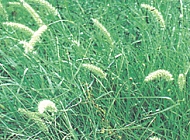
Buffel grass
| Name: | Buffel Grass (Cenchrus ciliaris) |
||||||||||||||||||||||||
|---|---|---|---|---|---|---|---|---|---|---|---|---|---|---|---|---|---|---|---|---|---|---|---|---|---|
| Description: | Perennial. Most growth during summer. Suited to a range of soils but favours those that are well drained. Avoid low fertility soils. Poor tolerance to waterlogging. Drought resistant; it responds quickly to light rain in all but the coldest months. Poor tolerance to frost. Buffel grass may out-compete native pastures. Not suited for a short-term pasture in a cropping rotation as its early growth is slow and it is difficult to remove by cultivation. It is only moderately palatable to stock, and pastures dominated by it are unsuitable for horses. The seed is fluffy, and difficult to sow with conventional machinery; preferably use seed that is one year old. Barrel medic is the most useful companion legume, seradella is useful in acidic soils. If sowing buffel grass with lucerne, reduce competition by reducing the sowing rate of lucerne to 0.75 kg/ha. Sow in spring or late summer to early autumn. |
||||||||||||||||||||||||
| Sowing rate: | Dryland alone 0.5–3.0 kg/ha. | ||||||||||||||||||||||||
| Minimum average annual rainfall |
(summer dominant) 700 mm. | ||||||||||||||||||||||||
| Select varieties on the basis of: | Maturity: Use the shortest maturing varieties to the far west of the growing area as they are more likely to establish and reproduce in low rainfall and highly variable climate. Use later maturing varieties to the east. Plant habit: Tall varieties tend to be less suited to sheep production than short varieties. Soil type: Buffel grasses are generally best suited to lighter textured soils, however, Biloela has grown well on heavier textured soils of NW NSW. |
||||||||||||||||||||||||
| Seed available: |
|
||||||||||||||||||||||||


